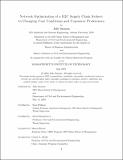Network Optimization of a D2C Supply Chain Subject to Changing Cost Conditions and Consumer Preferences
Author(s)
Sarasua, Julie
DownloadThesis PDF (1.258Mb)
Advisor
Willems, Sean
Simchi-Levi, David
Terms of use
Metadata
Show full item recordAbstract
This thesis examines and models the fulfillment operations of a US, medium-sized, direct-to-consumer (D2C) healthcare distributor that competes with lower-priced alternatives (e.g. Amazon) through high-service and deep customer relationships. Recent inflationary trends have pushed the company to seek new ways to reduce cost. Therefore, this thesis focuses on methods to lower operational cost via network optimization.
This work attempts to solve the network layout problem through two primary approaches: (1) Integer Programming using the Gurobi optimization python package and (2) Scenario Analysis modeling the cost of feasible configurations of the uncapacitated facility layout problem under the company’s existing order allocation logic. Both approaches result in similar solutions with the second deemed more interpretable by leadership and more aligned with existing IT logic in terms of order-facility allocation. Both models are successfully able to show a decrease in total landed cost of fulfillment relative to the base case. Qualitative considerations are discussed, as well as model sensitivity to changing environmental inputs (e.g. population shifts and changes in cost).
A concurrent project examining the reduction of shipping expense by incentivizing subscription-based customers to order less frequently (e.g. consolidating two orders into just one shipment), thereby maintaining revenues while lowering shipping expense. Two proposed solutions are examined: (1) existing incentives and (2) new incentives. The first was tested and showed preliminary positive impact to cost.
The company referenced in this work has been renamed as “DistroCo” for privacy. Sensitive figures, data, and information may be redacted or masked.
Date issued
2023-06Department
Sloan School of Management; Massachusetts Institute of Technology. Department of Civil and Environmental EngineeringPublisher
Massachusetts Institute of Technology